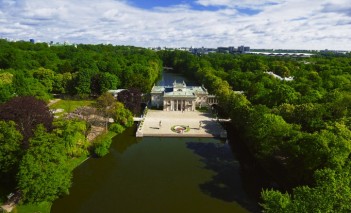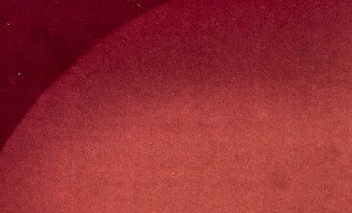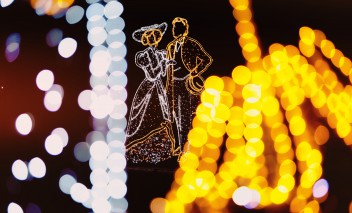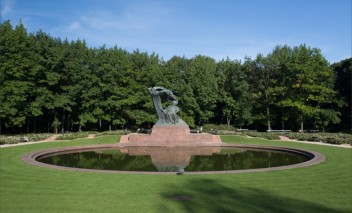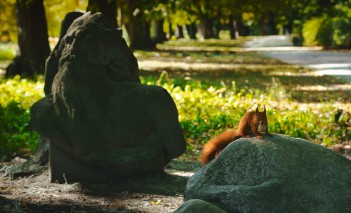Exhibition: "Ursula von Rydingsvard. Nothing but Art"

Sculptures by Ursula von Rydingsvard, one of American most recognisable artists, are on display at the Royal Łazienki Museum from 5 October 2021 to 13 February 2022. These are two works that are representative of her oeuvre – the polyurethane resin Elegantka II and For Natasha, a work made of cedar wood.
Ursula von Rydingsvard is one of the few sculptors in the world to create such monumental forms. Her sculptures impress with their dynamism. They testify to the artist’s extraordinary ability to create poetic works from cedar wood, her main sculpting material. In her projects, she transcends cultural and technological boundaries. She combines precision of workmanship that is close to medieval craftsmanship with modern abstract art, giving her works a unique character.
Elegantka II and For Natasha in the Royal Łazienki
Two sculptures by Ursula von Rydignsvard are on display at the Royal Łazienki Museum. Elegantka II, made of polyurethane resin with a light placed inside, is exhibited on the lawn next to the Old Orangery (during the gardens’ opening times, i.e. from Monday to Sunday from 6.00 to 20.00).
Inside the building visitors can admire the work For Natasha, created from cedar wood. The exhibition in the Old Orangery can be accessed with the pass to all museum facilities, which costs 40 zlotys – normal ticket, 20 zlotys – reduced ticket. Visiting times: Tuesday-Thursday from 10.00 to 16.00, Friday-Saturday from 10.00 to 17.00, on Sunday from 10.00 to 16.00.
Elegantka II is a polyurethane resin cast of another full-size cedar model. The author began working with this material in 2002, when she created the work Katul, Katul. Further works followed: Luna, Elegantka and Elegantka II as well as Damski Czepek, which are presently at display at the Yorkshire Sculpture Park in Great Britain.
Elegantka II takes the form of a robust column that gently turns around its axis like a Renaissance serpentinata figure. It expands from a narrow base to an abundant apex. Cast in resin, the work is light and ephemeral. The surface texture of the sculpture changes from the finely carved base, through the jagged central section, to the gentle undulations of the upper body. Illuminated from inside, the sculpture gains a poetic glow owing to the translucent resin. Elegantka II was presented at the 56th Biennale at the Giardino dela Marineressa in Venice in 2015 and in the Sculpture Garden of the Philadelphia Museum of Art.
The sculpture For Natasha was made in 2015 from cedar wood, which is characteristic of the artist. The author became interested in it as sculpting material towards the end of her studies at Columbia University in New York, when her friend Michael Mulhern, an Irish monk, brought a sample of cedar wood to the atelier. Cedar wood, soft and easy to work with, was perfect for building large sculptures. Ursula von Rydingsvard uses wood that is already machine-cut into pieces of a section of four-by-four inches. The creative process, which is very labour-intensive and sometimes takes several months or even more than a year, is very important to her. It requires a lot of strength, physical stamina and determination.
Large-scale cedar sculptures assembled and arranged into dynamic forms are cut, sliced with circular saws operated by her assistants in the atelier. The artist does not make any models or sketches beforehand. She works directly with the material in an intuitive way, comparing her creative process to composing jazz music.
Three museums, three presentations of the artist’s works
This year’s exhibition of Ursula von Rydignsvard’s art is the second presentation of her work in Poland (the first took place in 1992 at the Ujazdowski Castle Centre for Contemporary Art in Warsaw). The exhibition is the result of cooperation between three institutions. In addition to the works in the Royal Łazienki, several other sculptures and drawings can be seen at the Centre of Polish Sculpture in Orońsko and the National Museum in Kraków. The show – called 'Ursula von Rydingsvard. Nothing but Art' – highlights the artist’s passion and total dedication to art.
The items are exhibited in Poland by the courtesy of Ursula von Rydingsvard and Galerie Lelong & Co. from New York. The exhibition is held under the honorary patronage of the Deputy Prime Minister, Minister of Culture, National Heritage and Sport, professor Piotr Gliński. It received a grant from Ministry of Culture, National Heritage and Sport for the task: "Organisation of the Exhibition of Ursula von Rydingsvard in Poland". The curator of the exhibition is Eulalia Domanowska.
The work of Ursula von Rydingsvard
The artist began her career in 1975, after graduating in art from Columbia University in New York. She cites Mark Rothko, Albert Giacometti Wassily Kandinsky, Sol Le Witt and Philip Guston as her spiritual guides. Searching for her own creative path, since the beginning she has created huge works in landscape, such as St. Martin Dream in Battery Park or Song of Saint Eulalia in the Artpark in Lewinston near New York.
One of crucial inspirations for her art is her own biography. She comes from a Polish-Ukrainian family who in Second World War were deported from the Podhale region to Germany for forced labour and then emigrated to the United States. Her childhood experiences and the country of origin have left an emotional mark on her works. Wooden bowls, tools, shovels and walls echo the family heritage and Central European art. Although she has never lived in Poland, she gives her sculptures Polish titles and feels connected to her homeland.
The artist has managed to develop an original art formula which places her among the greatest art figures of the 20th century and our times. She is the author of dozens of monumental outdoor sculptures and sculpture installations, including Ene Due Rabe and Land Rollers at the Storm King Art Centre near New York, Hand-e-over for the Microsoft Collection in Richmond, the sculptures Anastasia, Pierwsza, Damski Czepek, Luna, Elegantka and Ogromna for the North Carolina Museum of Art, as well as Scratch and Bronze Bowl with Lace – a six-foot tall lofty form – the largest of her works, currently located at the Philadelphia Museum of Art.


